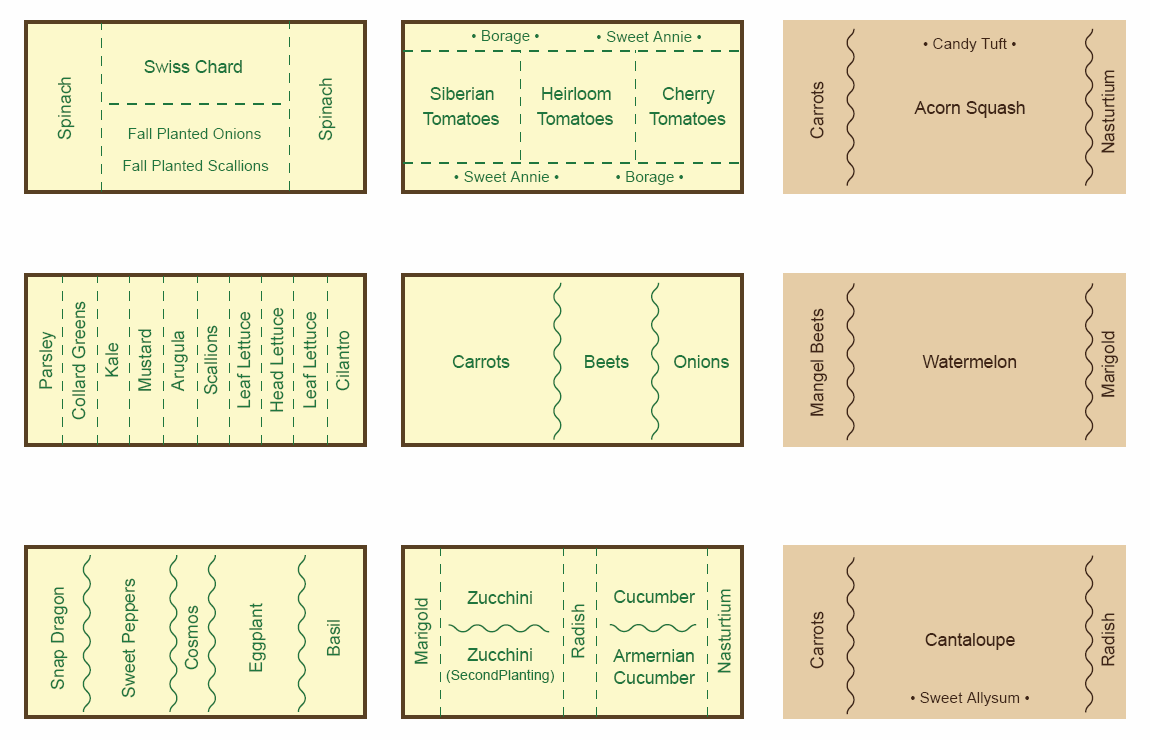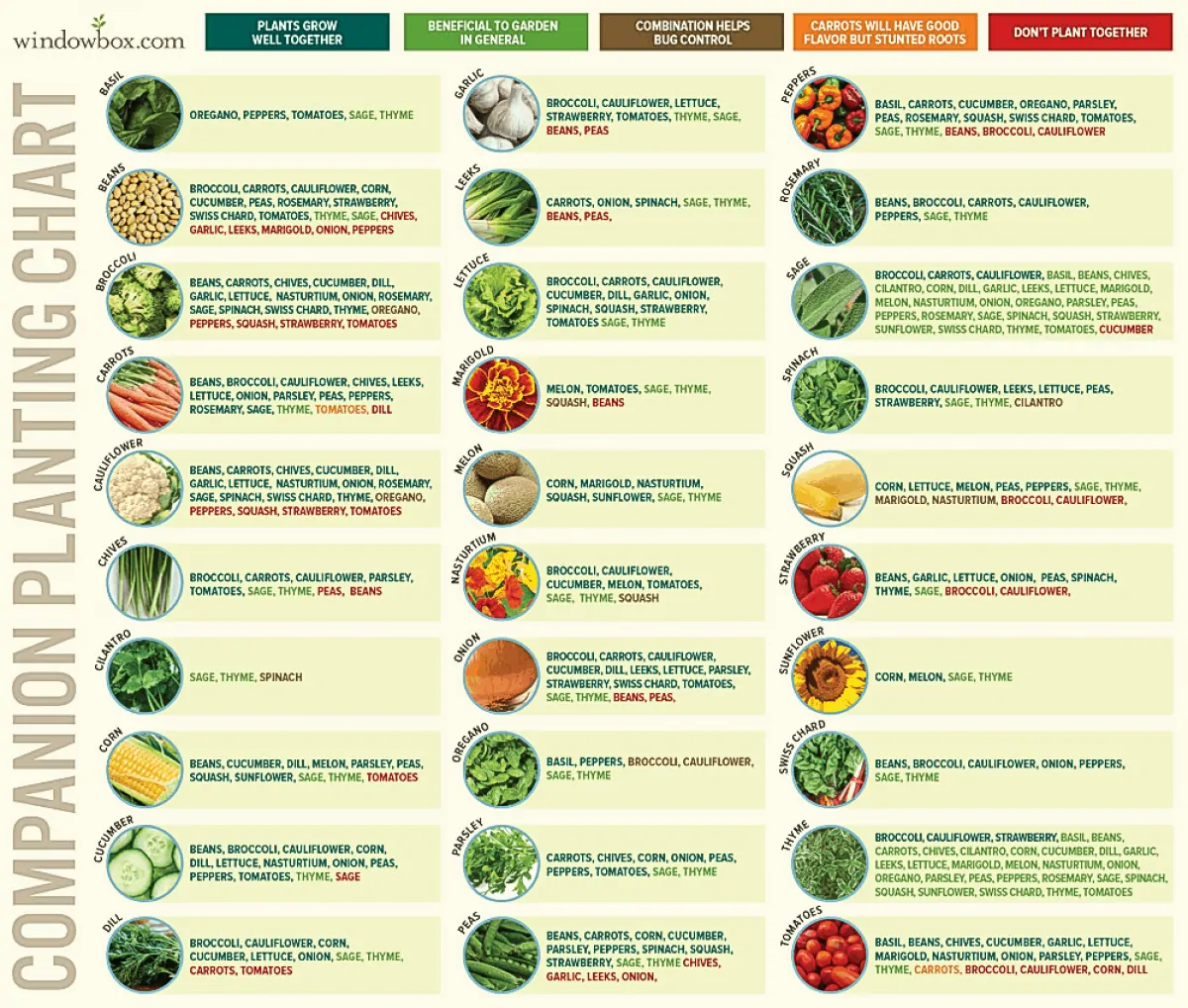Companion planting chart printable sets the stage for this enthralling narrative, offering readers a glimpse into a story that is rich in detail and brimming with originality from the outset.
Discover the benefits of companion planting, explore step-by-step instructions for creating a chart, find printable templates, learn how to use the chart effectively, and get inspired by success stories and expert tips.
Introduction to Companion Planting

Companion planting is a gardening technique where different plants are grown together to benefit each other. It involves carefully planning and organizing which plants to place next to each other based on their compatibility and the positive interactions they can have.
This method has been used for centuries and offers several benefits for gardeners.One of the main advantages of companion planting is pest control. Some plants naturally repel pests or attract beneficial insects that prey on pests. For example, marigolds are known to repel nematodes, while planting dill near cabbage can deter cabbage worms.
By strategically placing these plants together, gardeners can reduce the need for chemical pesticides and create a more balanced ecosystem in their garden.Companion planting can also improve soil fertility. Certain plants have the ability to fix nitrogen in the soil, which is essential for the growth of other plants.
If you’re looking for blank bingo cards that you can easily print, look no further. You can find a great selection of printable blank bingo cards at blank bingo cards printable . These cards are perfect for various occasions, from family game nights to classroom activities.
With blank spaces ready to be filled in, you can customize the cards to fit your needs. Whether you want to create traditional bingo games or add a twist with your own unique rules, these printable cards are a convenient and fun option.
Legumes like peas and beans, for instance, have symbiotic relationships with nitrogen-fixing bacteria in their root nodules. When these plants are grown alongside nitrogen-demanding crops like corn or tomatoes, they help enrich the soil with nitrogen, promoting healthier growth.In addition to pest control and soil fertility, companion planting can enhance crop productivity.
Some plants have complementary growth habits or root structures that allow them to share resources efficiently. For example, tall plants like corn can provide shade and wind protection for more delicate plants like lettuce. Similarly, plants with deep taproots can help break up compacted soil, improving water drainage for shallow-rooted plants nearby.Planning
and organizing companion plantings is crucial for maximizing the benefits. It is important to consider factors such as plant compatibility, growth habits, and nutrient requirements. Creating a companion planting chart or using a reference guide can help gardeners make informed decisions when designing their garden layout.
Examples of Common Companion Plants and Their Positive Interactions
Companion planting involves pairing plants that have mutually beneficial relationships. Here are some examples of common companion plants and their positive interactions:
- Tomatoes and basil: Basil repels tomato hornworms, while tomatoes enhance the flavor of basil.
- Carrots and onions: Onions deter carrot flies, while carrots help loosen the soil for onions.
- Cucumbers and radishes: Radishes repel cucumber beetles, while cucumbers provide shade for radishes.
- Beans and corn: Beans fix nitrogen in the soil, benefiting nitrogen-demanding corn plants.
These are just a few examples, and there are many more combinations that can be explored. The key is to observe and experiment to find the best companion plants for your specific garden.Remember, companion planting is not a guaranteed solution to all gardening problems, but it can greatly contribute to a healthier and more productive garden.
By understanding the positive interactions between plants, you can create a harmonious and thriving garden ecosystem.
Creating a Companion Planting Chart: Companion Planting Chart Printable

Companion planting charts are useful tools for gardeners to plan and organize their planting beds. These charts provide information on which plants are beneficial or detrimental when planted together. By using a companion planting chart, gardeners can maximize the health and productivity of their plants, improve pest control, and optimize nutrient utilization.To
create a companion planting chart, follow these step-by-step instructions:
Step 1: Research Plant Compatibility
- Start by researching the compatibility of different plant species. Some plants have synergistic relationships, while others may inhibit each other’s growth.
- Consider factors such as nutrient requirements, growth habits, and root systems when determining plant compatibility.
- Refer to reliable gardening resources or consult experienced gardeners for information on plant compatibility.
Step 2: Determine Pest Control, Companion planting chart printable
- Identify plants that have natural pest-repellent properties or attract beneficial insects.
- Include these plants in your companion planting chart to help control pests and reduce the need for chemical pesticides.
- For example, marigolds are known to repel nematodes, while planting basil near tomatoes can deter aphids.
Step 3: Consider Nutrient Needs
- Take into account the nutrient needs of different plants when designing your companion planting chart.
- Some plants have symbiotic relationships where they enhance each other’s nutrient uptake.
- For instance, legumes like beans and peas have nitrogen-fixing bacteria in their roots, which enrich the soil with nitrogen that benefits neighboring plants.
Printable Companion Planting Chart Templates

When it comes to companion planting, having a printable chart can be incredibly helpful for gardeners. These charts provide a quick and easy reference guide to help determine which plants are compatible with each other and which ones should be kept separate.
If you’re looking for printable companion planting chart templates, here are some reliable websites and resources you can check out:
List of Reliable Websites and Resources
- The Old Farmer’s Almanac : The Old Farmer’s Almanac offers a comprehensive companion planting chart that includes a list of 10 common vegetables and their compatible and incompatible companions.
- Savvy Gardening : Savvy Gardening provides several printable companion planting charts, including charts for vegetables, herbs, and flowers.
- GrowVeg : GrowVeg offers a variety of companion planting charts, categorized by plant type, season, and pest control.
- The Spruce : The Spruce has a collection of printable companion planting charts, featuring charts for vegetables, herbs, and flowers.
Types of Companion Planting Charts
Companion planting charts come in different types, each serving a specific purpose. Here are some common types of companion planting charts:
- By Plant:These charts focus on specific plants and provide information on which plants grow well together and which ones should be avoided.
- By Season:Seasonal companion planting charts help determine which plants can be grown together during different seasons, taking into account their growth requirements and compatibility.
- By Pest Control:These charts recommend companion plants that help repel pests or attract beneficial insects, promoting natural pest control in the garden.
Choosing the Right Companion Planting Chart Template
When choosing a companion planting chart template, consider the specific needs of your garden. Here are some tips to help you choose the right one:
- Identify the plants you want to grow and look for charts that include those specific plants.
- Consider the growing season and choose a chart that is tailored to your region’s climate and planting schedule.
- If pest control is a concern, opt for a chart that focuses on companion plants known for their pest-repellent properties.
- Look for charts that are well-organized and easy to read, with clear information and plant pairings.
- Consider the format of the printable chart, whether it’s a PDF file, a downloadable image, or a printable webpage.
How to Use a Companion Planting Chart

Companion planting charts are valuable tools for planning and organizing your garden. They provide information about which plants grow well together and which plants should be kept apart. Here’s a step-by-step guide on how to effectively use a companion planting chart.
Understanding the Chart
Before using a companion planting chart, it’s important to understand the information presented. Most charts use symbols or icons to represent different plants. Take some time to familiarize yourself with the key or legend provided on the chart. It will explain what each symbol means and how to interpret the information.
Are you interested in building your own RC boat? With 3D printing technology, it’s now easier than ever. Check out 3d printable rc boat for a wide range of downloadable files and resources. You’ll find everything you need to bring your dream boat to life.
From hull designs to propellers, these printable files allow you to customize and personalize your RC boat. Whether you’re a beginner or an experienced builder, 3D printable RC boats offer endless possibilities for creativity and excitement.
Choosing Companion Plants
To use the chart effectively, start by selecting the main plant you want to grow. Look for its symbol or name on the chart and identify the plants that are listed as good companions. These are the plants that can be planted alongside your main plant to promote its growth and health.
Planting Layout
Once you have identified the companion plants, consider the layout of your garden. Group the compatible plants together, making sure to leave enough space for each plant to grow. This will help create a harmonious environment where the plants can support each other.
Beneficial Combinations
Here are some common examples of companion planting combinations and their benefits:
Tomato and Basil
Basil repels pests that commonly affect tomatoes, such as aphids and hornworms.
Carrots and Onions
Onions deter carrot flies, while carrots help loosen the soil for onions to grow.
Marigolds and Beans
Marigolds repel harmful nematodes and attract beneficial insects that pollinate beans.
Updating the Chart
Throughout the growing season, it’s important to update and adjust your companion planting chart as needed. Keep track of how well the plants are growing together and make note of any issues or successes. If you notice that certain combinations are not working well, you can make changes and experiment with different companions.Remember,
companion planting is not an exact science and may vary depending on your specific garden conditions. Use the chart as a guide, but also trust your observations and intuition as you learn what works best in your garden.
Companion Planting Success Stories

Companion planting techniques have been proven to be effective in promoting healthier and more productive gardens. Many experienced gardeners have shared their success stories, highlighting the specific benefits and positive outcomes they have observed.
Improved Pest Control
One common benefit reported by gardeners is improved pest control. By strategically planting certain companion plants together, gardeners have found that they can naturally deter pests and reduce the need for chemical pesticides. For example, planting marigolds alongside tomatoes helps to repel nematodes and aphids, while attracting beneficial insects like ladybugs.
Enhanced Soil Fertility
Companion planting can also contribute to enhanced soil fertility. Some plants have the ability to fix nitrogen in the soil, which is an essential nutrient for plant growth. For instance, planting legumes such as beans or peas alongside nitrogen-demanding crops like corn or squash can provide a natural source of nitrogen, reducing the need for synthetic fertilizers.
Increased Crop Yield
Gardeners have reported increased crop yields as a result of companion planting. Certain plant combinations have been found to enhance each other’s growth and productivity. For example, planting basil alongside tomatoes not only improves the flavor of the tomatoes but also enhances their growth and yield.
Weed Suppression
Companion planting can help suppress weeds in the garden. Some plants, like ground cover crops or dense foliage plants, can act as natural weed barriers. For instance, planting a cover crop such as clover or vetch between rows of vegetables can help smother weeds and prevent their growth.
Examples of Successful Companion Planting Combinations
Here are some examples of companion planting combinations that have worked well for different types of plants:
- Planting carrots and onions together helps to repel pests such as carrot flies and onion maggots.
- Growing beans and corn together benefits both crops, as the beans provide nitrogen to the corn while the corn provides support for the beans to climb.
- Planting herbs like rosemary or sage near brassicas like cabbage or broccoli can deter cabbage worms and other pests.
- Growing marigolds near beans can help repel Mexican bean beetles.
- Planting nasturtiums near squash or cucumbers can deter squash bugs and beetles.
Companion planting has been a valuable technique for many gardeners, offering a natural and sustainable way to promote plant health and increase garden productivity. By learning from these success stories and experimenting with different companion planting combinations, gardeners can create thriving and harmonious gardens.
Tips and Tricks for Companion Planting

Companion planting is a valuable technique that can help improve the health and productivity of your garden. Here are some additional tips and tricks to make your companion planting efforts successful.
Choosing the Right Companions
When selecting companion plants, it’s important to consider their compatibility. Some plants have natural affinities for each other and can benefit from being grown together, while others may compete for resources or attract pests. Research the specific needs and characteristics of each plant to ensure they are good companions.
- Plant marigolds near your vegetable crops to deter pests like aphids and nematodes.
- Growing basil alongside tomatoes can enhance their flavor and repel insects.
- Beans and peas are nitrogen-fixing plants, so they can help improve the soil for neighboring plants.
- Avoid planting members of the same plant family together, as they are more likely to attract diseases and pests.
Avoiding Common Mistakes
To maximize the benefits of companion planting, it’s important to avoid common mistakes that can hinder its effectiveness.
- Avoid overcrowding your plants. Give them enough space to grow and access sunlight and nutrients.
- Do not rely solely on companion planting to solve all your gardening problems. It should be used in conjunction with other sustainable gardening practices.
- Do not ignore the specific needs of individual plants. Even if they are good companions, they still require appropriate care and conditions to thrive.
- Do not forget to rotate your crops each season to prevent the buildup of pests and diseases.
Companion Plants for Different Climates
The success of companion planting can vary depending on the climate and growing conditions of your region. Here are some suggestions for companion plants that work well in different climates:
| Climate | Companion Plants |
|---|---|
| Hot and arid | Aloe vera, lavender, sunflowers |
| Cool and damp | Cabbage, kale, lettuce |
| Tropical | Bananas, papayas, sweet potatoes |
Observing and Adapting
It’s important to observe your garden and adapt your companion planting strategies based on the specific needs of your plants and the conditions in your garden.
- Monitor your plants for signs of pest or disease infestations. If a companion plant is not providing the desired benefits, consider trying a different companion.
- Keep a gardening journal to record your observations and track the success of your companion planting efforts over time.
- Be open to experimenting with different companion planting combinations and adjusting them as needed.
Remember, companion planting is not an exact science and what works well for one gardener may not work as effectively for another. It’s important to find the best companion planting strategies that work for your specific garden and individual needs.
